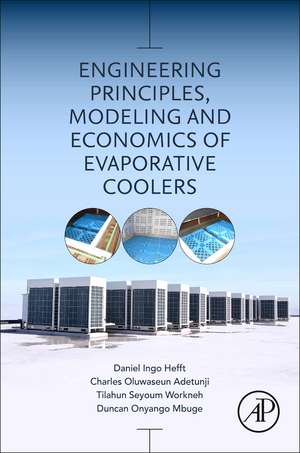Engineering Principles, Modeling and Economics of Evaporative Coolers
Editat de Daniel Ingo Hefft, Charles Oluwaseun Adetunji, Tilahun Seyoum Workneh, Duncan Onyango Mbugeen Limba Engleză Paperback – 26 iun 2023
Evaporative coolers are an ancient technology, invented long before the introduction of chemical refrigerants as used in modern fridges or cooling towers. This two volume set covers the topic, with practical applications, construction techniques, and operation of the technology.
- Thoroughly explores unit operations and engineering principles of evaporative coolers
- Includes CFD modelling on evaporative cooling structures
- Covers the economics of evaporative coolers
Preț: 671.30 lei
Preț vechi: 878.20 lei
-24% Nou
Puncte Express: 1007
Preț estimativ în valută:
128.45€ • 134.83$ • 106.62£
128.45€ • 134.83$ • 106.62£
Carte indisponibilă temporar
Doresc să fiu notificat când acest titlu va fi disponibil:
Se trimite...
Preluare comenzi: 021 569.72.76
Specificații
ISBN-13: 9780323900393
ISBN-10: 0323900399
Pagini: 338
Dimensiuni: 152 x 229 x 20 mm
Greutate: 0.52 kg
Editura: ELSEVIER SCIENCE
ISBN-10: 0323900399
Pagini: 338
Dimensiuni: 152 x 229 x 20 mm
Greutate: 0.52 kg
Editura: ELSEVIER SCIENCE
Cuprins
1. Evaporative coolant structure as a sustainable storage structure for extending the shelf life of food produce
2. Historic use of evaporative coolant structures by continent
3. Modern cooling and its advantages and disadvantages: A review
4. Theoretical design principles and practice of evaporative cooler
5. Evaporative cooling principles: Direct, indirect, indirect air cooling, and direct evaporative cooling
6. Evaporative coolant structure as an alternative to cold storage or controlled atmosphere storage for the preservation of fruits and vegetables
7. Construction of different types of evaporative coolant structure for preservation of fruits and vegetables
8. Zero-energy evaporative cooling technology and the prospective for fresh produce postharvest handling most especially for the preservation of fruits and vegetable
9. Application of natural material such as charcoal in evaporative coolant structure
10. The challenges and solutions to corrosion and other forms of construction material degradation in evaporative cooling structures
11. Recent advances in the application of sensors used in evaporative coolers to monitor chamber environmental parameter
12. Alternative energy sources that could be utilized in the operation of evaporative coolant structures most especially in rural communities
13. Edible coatings and evaporative cooling best practice guidelines for extension of preservation of fruits and vegetables
14. Computational fluid dynamics (CFD) analysis of airflow inside an evaporative cooler for storage of fruits and vegetables
15. Socio-economic aspect of evaporative coolant structure
16. Role of government and policymakers towards supporting the deployment of evaporative coolant structure
17. Renewable energy integration into a low-cost evaporative cooling system for fresh produce storage
18. Numerical and experimental investigation of the potential of combining evaporative cooler with a CoolBot air conditioner for a low-cost tomato cold storage
19. Application of computational fluid dynamics modelling for coolers
20. The influences of different cold storage environments on the mechanical and physiological quality of stored amadumbe (Colocasia esculenta L. Schott)
21. Development of evaporative coolers over time
2. Historic use of evaporative coolant structures by continent
3. Modern cooling and its advantages and disadvantages: A review
4. Theoretical design principles and practice of evaporative cooler
5. Evaporative cooling principles: Direct, indirect, indirect air cooling, and direct evaporative cooling
6. Evaporative coolant structure as an alternative to cold storage or controlled atmosphere storage for the preservation of fruits and vegetables
7. Construction of different types of evaporative coolant structure for preservation of fruits and vegetables
8. Zero-energy evaporative cooling technology and the prospective for fresh produce postharvest handling most especially for the preservation of fruits and vegetable
9. Application of natural material such as charcoal in evaporative coolant structure
10. The challenges and solutions to corrosion and other forms of construction material degradation in evaporative cooling structures
11. Recent advances in the application of sensors used in evaporative coolers to monitor chamber environmental parameter
12. Alternative energy sources that could be utilized in the operation of evaporative coolant structures most especially in rural communities
13. Edible coatings and evaporative cooling best practice guidelines for extension of preservation of fruits and vegetables
14. Computational fluid dynamics (CFD) analysis of airflow inside an evaporative cooler for storage of fruits and vegetables
15. Socio-economic aspect of evaporative coolant structure
16. Role of government and policymakers towards supporting the deployment of evaporative coolant structure
17. Renewable energy integration into a low-cost evaporative cooling system for fresh produce storage
18. Numerical and experimental investigation of the potential of combining evaporative cooler with a CoolBot air conditioner for a low-cost tomato cold storage
19. Application of computational fluid dynamics modelling for coolers
20. The influences of different cold storage environments on the mechanical and physiological quality of stored amadumbe (Colocasia esculenta L. Schott)
21. Development of evaporative coolers over time
